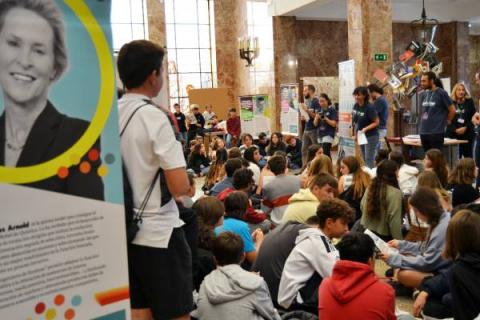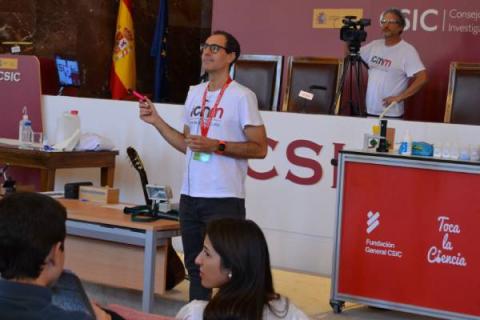The ICMM breaks its own record and brings together almost a thousand people at the European Night of Researchers, at CSIC

What do a dockside show, color-injected tobacco plants, sighted sounds, flying ghosts, and forgotten female scientists have in common? Easy: everything is part of the great European Night of Researchers event that the CSIC centers on the Cantoblanco campus have once again celebrated. It's already been three years since ten centers have come together to create the best synergy: an event, dozens of scientists who show what their work consists of... and how science is more fun than it sometimes seems.
"It's very funny and inspiring to see their faces", commented María José Calderón (ICMM) when leaving her superconductivity show, one of the most applauded of the event since it is she who makes the famous Cooper ghost 'fly'. She received ovations and applause from a dedicated audience: students from 5th grade to 2nd year of Baccalaureate who not only discovered the secret of materials that, when cooled, stop resisting the passage of electric current.
They also learned that ceramics are much more than earthenware pitchers, they discovered the powers of chemistry to make light (because fluorescence, phosphorescence, or chemiluminescence are not the same, and Íñigo Bretos made it very clear) and they were surprised to learn that springs are much more than simple springs (and this far we can read).

More than 400 students came to the CSIC headquarters with their respective teachers, but they were not the only ones: the science fair began for the general public at 5:00 p.m., and the result could not have been more satisfactory for the attendees. In shifts of 100 people every hour, by the night's end, almost a thousand people had crossed the columned portal of Calle Serrano to enjoy workshops and scientific talks of all levels.
Isabel Díaz, from the ICP, spoke about her project to decontaminate waters in Ethiopia with Zeolites, then Guillermo García-Sánchez, from ICMAT, talked about maths and cleaning oceans, and later it was the turn of Miguel Ángel Sánchez-Conde, an IFT researcher who explained what the violent (and dark) universe is like to gamma-ray light. So far the talks, but not the workshops: the hundreds of visitors were able to see the sound, inject color into tobacco plants, generate electricity from heat, understand the vibrations of the world and learn that the 'empty' is much more than a hackneyed poetic metaphor. Even the president of the CSIC, Eloísa del Pino, came to the fair and enjoyed each of the workshops. She herself commented on Twitter how the word "democracy" 'looks'.
Así es y esta es la palabra "democracia" digitalizada y ceramizada https://t.co/GLn8pM9cSe pic.twitter.com/ZOJ4LNmvL6
— Eloísa del Pino (@delPinoE) September 30, 2022
"I have seen another part of science, more fun and more practical, and we have learned new things about women," Maribel and Carlota, 3rd year ESO students, recounted on their way out. Elena, one of her teachers at the Amanecer school (Madrid), summed up the entire day as follows: "Being able to be with scientific staff is a privilege." "The women have won great prizes," concluded Malak and Andrea, from the Virgen de la Vega school in Fuenlabrada. They were impressed with another of the jewels in the crown: the escape road, which did not fail to bring together visitors who challenged themselves to get to know these great women that history has forgotten. Science, history, and a record. Next year, for more.
-- Ángela R. Bonachera (ICMM Comunication).
Instituto de Ciencia de Materiales de Madrid (ICMM)
Sor Juana Ines de la Cruz, 3
Cantoblanco, 28049
Madrid, España
Telephone: (+34) 91 334 90 00
Email: @email
Communication Office: @email

Acknowledge the Severo Ochoa Centres of Excellence program through Grant CEX2024-001445-S/ financiado por MICIU/AEI / 10.13039/501100011033

Contacto | Accesibilidad | Aviso legal | Política de Cookies | Protección de datos